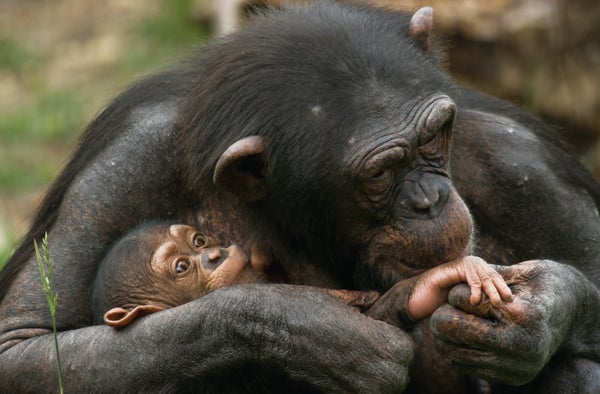Apart from some rear-guard behaviorists, few people hesitate to ascribe empathy to their dogs. But then dogs are man’s best friend, freely credited with lots of human sentiments. For as much as we empathize with our canines, we have been stingy about recognizing empathy elsewhere in the animal kingdom, reserving it as a human trait. This belief is changing, however, as a growing line of research demonstrates not just empathy’s existence in other animals but its subtleties and exceptions as well. And they shed some interesting light on how we developed our capacity for caring for others.
Early Studies
The surge in empathy studies during the past decade revives a line of research started more than half a century ago. In 1959 a paper by psychologist Russell Church appeared in the Journal of Comparative & Physiological Psychology, provocatively entitled “Emotional Reactions of Rats to the Pain of Others.” Church first trained rats to obtain food by pressing a lever. He found that if a rat pressing the lever saw another rat in a neighboring cage receive a shock from an electrified cage floor, the first rat would interrupt its activity—a remarkable result. Why shouldn’t the rat continue to get food and simply ignore the other animal’s flinching? The bigger question was whether the rats that had stopped pressing the lever were worried about their companions or just afraid that something bad might happen to them as well.
On supporting science journalism
If you're enjoying this article, consider supporting our award-winning journalism by subscribing. By purchasing a subscription you are helping to ensure the future of impactful stories about the discoveries and ideas shaping our world today.
Church’s work inspired a brief flurry of research during the 1960s that investigated the presence of “empathy,” “sympathy” and “altruism” in animals. To avoid troublesome skepticism from colleagues, the investigators made sure to place the topics of their research in quotation marks; the prevailing behaviorist atmosphere made mention of animal emotions an anathema. Combined with the traditional emphasis on nature’s nasty side, this taboo ensured that these studies went largely ignored.
In the meantime, however, human empathy became a respectable study topic. First, in the 1970s, came studies of empathy in young children; then, in the 1980s, in adults. Finally, in the 1990s, researchers began placing humans in brain scanners to monitor them while they watched others who were in pain or distress or who had a disgusted facial expression—revealing many intriguing findings about activity in the brain. This field now produces new articles every week. But for quite some time, animal studies lagged.
An Old Sorrow
This sluggish pace began changing more than a decade ago. Slowly but steadily, some 50 years after Church’s rat study, the evolutionary origin of empathy became a hot topic, reviving interest in studies of whether animals experience this complex and socially vital connection to others. Psychologist Stephanie D. Preston of the University of Michigan and I have argued that a basic neural process, first developed in our animal ancestors, underlies even the sophisticated kinds of empathy that only we humans are capable of. Seeing another person in a certain situation reactivates neural representations of when we ourselves have been in similar situations; this brain activity, in turn, generates a body state resembling that of the object of our attention. Thus, to see another’s pain may lead us to share it.

Two Icelandic horses stand nuzzling. Credit: Liz Tormes
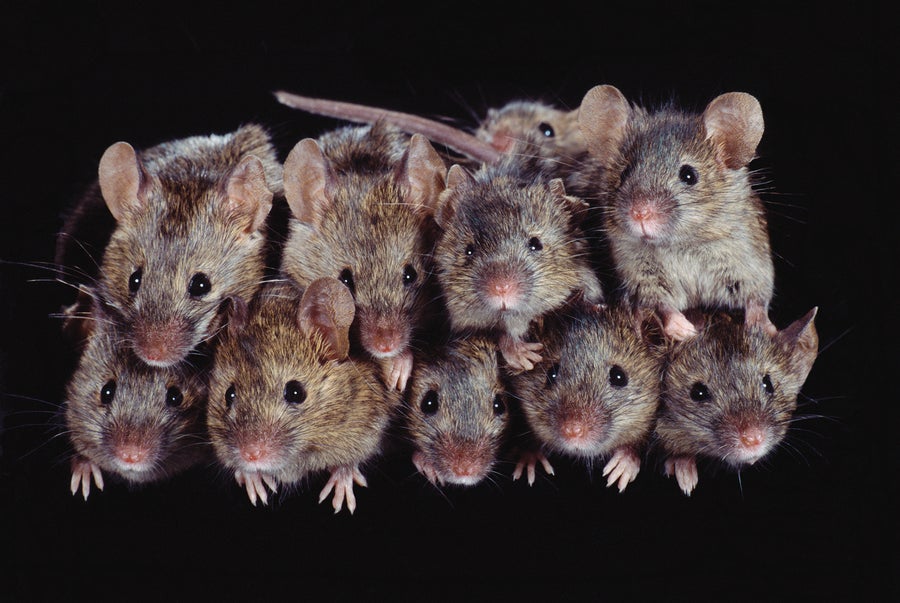
If rodents show empathy, the capacity may be widespread indeed. A mouse study has indicated greater empathy toward cage mates than toward strangers. Credit: Renaud Visage Getty Images
This empathetic capacity is in place on the very first day of a person’s life. You can see it in any maternity ward, where all newborns will start crying as soon as one of them gets going. Artificial noise fails to cause the same reaction: babies are particularly sensitive to the distress calls of their own species. I have seen a similar spread of distress in young rhesus monkeys. Once, when an infant monkey had been bitten, it screamed so incessantly that it was soon surrounded by other infants. I counted eight of them climbing on top of the poor victim, pushing, pulling and shoving one another as well as the first infant. The response seemed automatic, as if the other infants were as distraught as the victim was and sought to comfort themselves as much as their companion.
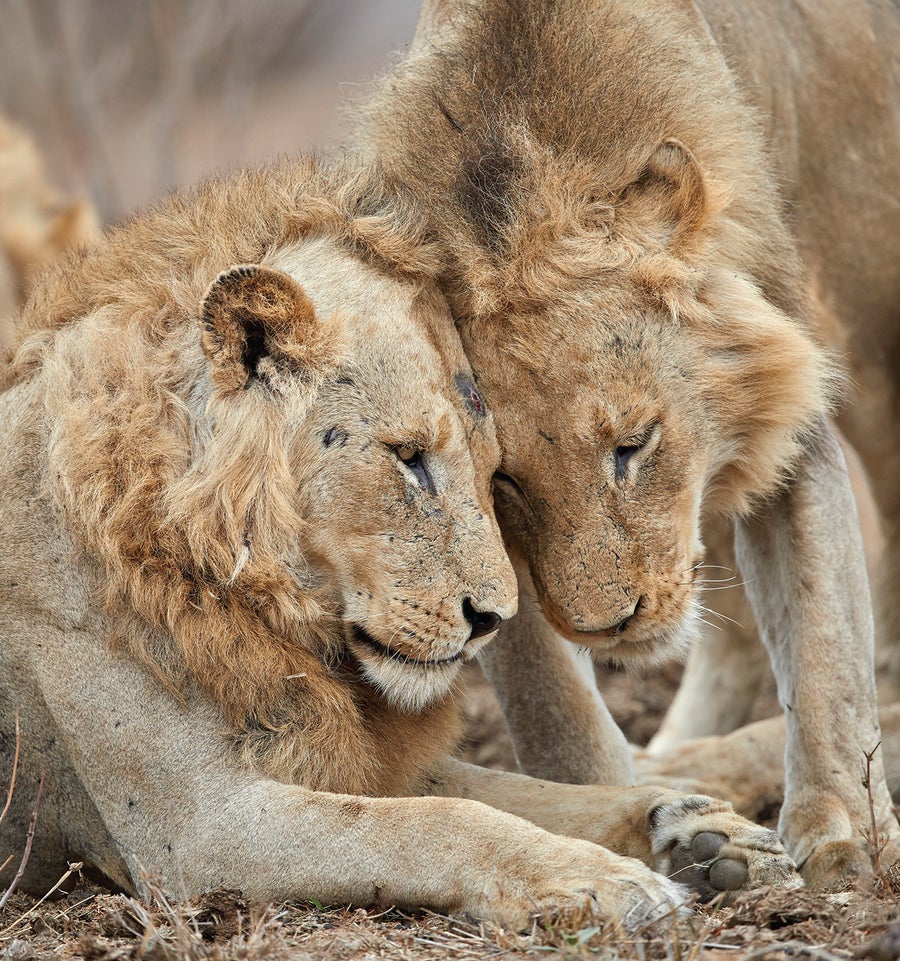
Male lions greet each other. Credit: James Hager Getty Images
The study of empathy in children started with measures of their reactions to a family member who had been instructed to cry. Very young children would approach and touch or stroke the distressed relative. This reaction became known as empathetic concern.
Now we know that some animals will do the same. Researchers have observed consolation responses in dogs, elephants and primates. After one chimpanzee has attacked another, for example, a bystander will go over to gently embrace the victim until he or she stops yelping.
The tendency to console is so powerful that Nadezhda Ladygina-Kohts (also known as Nadia Kohts), a Russian scientist who raised a juvenile chimpanzee about a century ago, said that if her charge had escaped to the roof of her house there was only one way to get him down. Holding out food would not do the trick: the only way would be for her to sit down and sob, as if she were in pain. The young ape would then rush down from the roof to put an arm around her.
In bonobos, research has shown that empathetic concern is related to emotion regulation. The young bonobos that are best at coping with mental suffering (they scream less if frightened or distressed) are also the first to provide reassurance to others in distress. They are able to comfort others because of their better capacity to tamp down their own emotions. Emotional control is also a major factor in human empathy. There are so many similarities between humans and apes—including the tendency of females to exhibit empathy more readily than males—that the most parsimonious assumption is that the behavior in both species reflects the same mechanism, which may be as old as the mammals.
One of the most rigorous and particularly revealing studies of animal empathy came in 2006 from Dale J. Langford, then a psychology graduate student at McGill University, and her colleagues in a paper entitled “Social Modulation of Pain as Evidence for Empathy in Mice,” published June 30, 2006, in Science. (Note that this time the word “empathy” is free of quotation marks; this absence reflects the growing consensus that emotional linkage between individuals probably has the same biological origin in humans and other animals.)
This study was inspired by a puzzle that Langford and her laboratory’s director, pain geneticist Jeffrey S. Mogil, found intriguing: when they tested mice from the same home cage in experiments that involved light shocks to the feet, the researchers noticed that the order in which the mice were tested seemed to affect their pain response. The first mouse would always show fewer signs of pain than the last. Was the last mouse being sensitized to pain by seeing others in pain? Or was something else at work?
To find out, Langford, Mogil and their colleagues devised an experiment in which pairs of mice were put through a so-called writhing test. In each trial, two mice were placed in two transparent Plexiglas tubes so that they could see each other. Either one or both mice were injected with diluted acetic acid, which is known to cause a mild stomachache. Mice respond to this discomfort with characteristic stretching movements. (This is less a “writhe” than a sort of discomfited restlessness.) The researchers found that an injected mouse would show more of this movement if its partner displayed the same behavior than it would if its partner had not been injected. Most significantly, this increased display occurred only in mouse pairs who were cage mates.
Male (and not female) mice showed an additional interesting phenomenon when witnessing a strange male mouse in pain: its own pain sensitivity would actually drop. This counterempathetic reaction occurred only in male pairs that did not know each other, which are probably the pairs with the greatest degree of rivalry. Was the rivalry suppressing their reaction, or did they feel less empathy for a strange mouse?
(This gender effect reminds me of a wonderful study of human schadenfreude that Tania Singer, then at the University of Zurich, and her colleagues published in early 2006 in Nature. The researchers found that in both men and women, seeing the pain of a person with whom one has just cooperated activates pain-related brain areas. But if a man felt he had been treated unfairly by another man in a previous exchange, his brain’s pleasure centers would light up at seeing the other’s pain. Such male antipathy toward rivals may be a mammalian universal.)
Finally, Langford and her colleagues also exposed pairs of mice to different sources of pain—the acetic acid as before and a radiant heat source that would cause pain if a mouse did not move away. Mice observing a cage mate suffering a stomachache withdrew more quickly from the heat source. In other words, the reactions of mice cannot be attributed to mere imitation, because a mouse seeing a companion in pain appears to be sensitized to any pain.
Foundation of Empathy
I admire this study greatly. It is not the kind of manipulation we would nowadays apply to primates, but it goes a long way toward confirming the tentative conclusions of the 1960s, with the benefits of more subjects and more rigorous controls. Although it does not prove that the mice feel vicarious emotions, it demonstrates that they experience a vicarious intensification of their own experience.
This demonstration justifies speaking of “empathy” outside of humanity—at least in some instances. Here we find an interesting division between psychologists, who tend to think in terms of top-down processes, and biologists, who tend to think from the bottom up. The top-down view considers the most advanced forms of empathy, such as putting yourself into another’s “shoes” and imagining his or her situation, and wonders how this ability arises; the inevitable answer is advanced cognition, perhaps even language. Yet merely imagining someone else’s situation does not constitute empathy. Such imagination can be a cold affair, not unlike understanding how airplanes fly. Empathy requires emotional involvement.
Here the bottom-up view offers a better perspective. When we react to seeing someone display emotion and construct an advanced understanding of the other’s situation, this process indeed involves—in humans and in some other large-brained animals—a great deal of cognition. But the emotional connection comes first; understanding and imagination follow. The mouse experiment suggests that the emotional component of this process is at least as old as our early mammalian ancestors and runs deep within us.
Empathy Is a Pain, So Why Bother?
By Peggy Mason
As Frans B. M. de Waal notes in the main article, the principles of biological continuity should make it unsurprising that mice act in empathetic ways similar to those seen in primates, including humans. The 2006 study by Dale J. Langford, then at McGill University, and her colleagues bolsters that view in striking ways.
For instance, it is tempting to explain empathetic behavior in animals that we believe to have only rudimentary cognition, such as mice, by arguing that the sight of a suffering fellow mouse simply evokes an automatic fear reaction. The Langford study undermines that explanation by finding that mice showed empathetic reactions only with cage mates; the mice seem to go far beyond being frightened by injury to accounting for whom the injured party is—friend, family, foe or stranger. This response is a significant step toward humanlike social feeling—caring for acquaintances more than for strangers, just as our empathy for someone who is hurt differs depending on whether the person is a foreigner, a national compatriot, a school chum or an immediate family member.
Reflection of Pain
So how can the brain accomplish empathy in general and empathy for pain in particular? One popular theory involves mirror neurons, discovered more than two decades ago by Giacomo Rizzolatti and his colleagues at the University of Parma in Italy. In Rizzolatti’s original 1996 study, he and his colleagues found that premotor neurons in a monkey’s prefrontal cortex—neurons that routinely fire as the monkey prepares a particular movement, such as reaching out to grasp something—fired in a similar pattern when the monkey merely watched the same task performed by another monkey or a human. The idea with respect to empathetically shared emotion is that affect-relevant neurons have mirror functionality, so that when an individual watches a loved one experience pain, these neurons discharge and create an affective state much like the viewer would feel if she were receiving the painful stimulus herself.
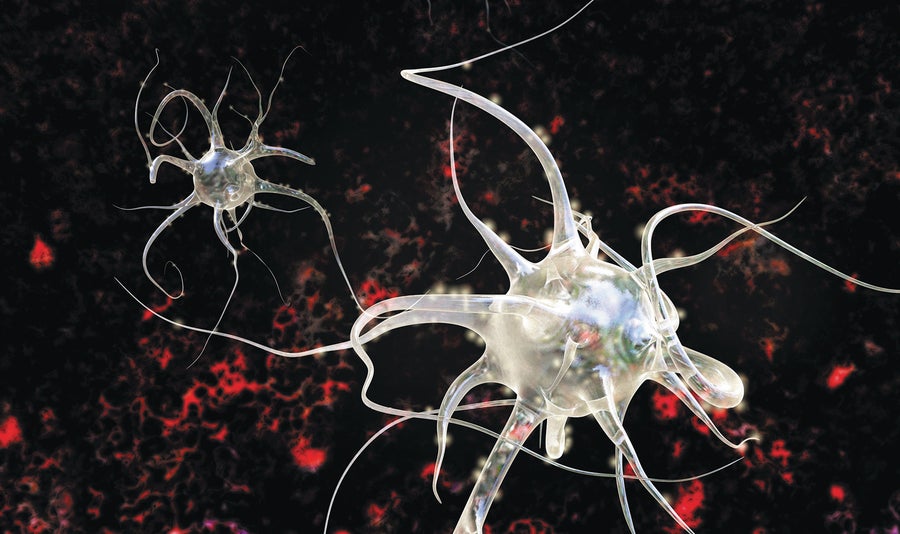
How can the brain accomplish empathy? One answer that is commonly put forward involves mirror neurons, brain cells (such as the ones depicted in the conceptual image here) that fire in response when a subject witnesses another animal or person perform a task—or experience pain. Credit: Getty Images
The notion that mirror neurons form the neural substrate for affective sharing is seductively attractive, but there are numerous fundamental problems with it. As articulated by Gregory Hickok in his book, The Myth of Mirror Neurons (W. W. Norton, 2014), any role for mirror neurons in empathy depends on these neurons being able to signal not only a motor action, such as reaching for a peanut, but also the intention behind that action—a desire to eat the peanut, for example. This is unlikely. The same movement may be used to achieve myriad different goals. At the time of an action, when the mirror neurons fire, the end goal of that action is yet to be revealed. Therefore, rather than coding for intention, mirror neurons may play a role in facilitating motor actions. A second major stumbling block for the hypothesis that mirror neurons are the basis for empathy is the lack of conclusive evidence for these neurons in any region of the human brain.
The Empathetic Brain
If mirror neurons are not responsible for sharing the pain experience between individuals, what is? For starters, it is clear that when it comes to pain, experiencing pain oneself and viewing another’s experience of pain activate overlapping, but not identical, brain areas in humans. Work by psychology professor Jean Decety of the University of Chicago has showed that brain regions important in emotional arousal, such as the midbrain periaqueductal gray and the anterior cingulate cortex, are co-activated during self-pain more than during other-pain, although both regions are activated under both pain conditions. On the other hand, activation of the medial prefrontal cortex, a region critical to executive function and self-regulation, is more connected to activity in the anterior cingulate cortex during another’s pain than during self-pain. Thus, despite the attractiveness of a paint-by-numbers interpretation of human brain-imaging data, individual brain areas do not determine individual emotional experiences. Instead circuits involving complex connections between specific areas of the brain shade our interpretation of our own feelings and others’.
The exciting work by Langford and her colleagues shows us that one mouse can discern the pain experience of another mouse and even alter its own behavior as a result. This may not be exactly the same as the other-oriented caring that one human offers to another human in pain, but it is one biological step closer to human experience than originally believed.
Peggy Mason is in the department of neurobiology at the University of Chicago. Inspired in part by writing this piece, she switched her scientific focus to empathetic helping in rats.
Turnabout Is Fair Play
Empathetic feelings can vary depending on context (graphs). In a study, men and women first cooperated with a partner and then saw that partner experience pain. In the men, pleasure centers in the nucleus accumbens (blue spot in inset image at bottom) activated if the partner had been unfair in the earlier exchange, indicating stronger feelings of revenge.
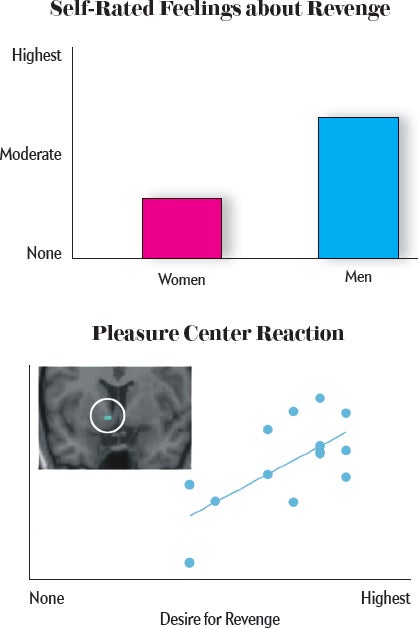
Source: "Empathic Neural Responses Are Modulated by the Perceived Fairness of Others," by Tania Singer et al., in Nature, Vol. 439; January 26, 2006; Courtesy of Tania Singer (inset)
The Author Answers Questions
As with most online news columns, Mind Matters at ScientificAmerican.com invites reader comments and questions. Unlike many such columns, however, inquiries often get answered by leading researchers—among them, the authors of posts about recent papers and other scientist visitors to the Web site—and by Scientific American editors. The sampling below includes an exchange between readers and Frans B. M. de Waal. —The Editors
It’s always baffled me that any anthropomorphism of animals is considered “unscientific” until the evidence supporting a particular instance is overwhelming. Occam’s razor leads one to the opposite point of view. If we accept certain types of behavior as being motivated by particular emotional or mental states in humans, it follows that, barring good evidence to the contrary, the simplest assumption would be that similar behaviors are motivated by similar internal states in animals. Any argument that can be applied to dismiss this in animals applies equally to humans. Why the false dichotomy? It makes no sense. —Kevin M.
Put simply, Occam’s razor relates to explanations and states that elements should not be multiplied beyond necessity. Animals being capable of empathy is by far more complex than if they weren’t. There is absolutely no reason for us to assume any similarity between our behavior patterns and those of animals. To do so would be in violation of Occam’s razor, not the other way around. To save ourselves confusion, it’s best to wait for theories like this to be backed up by studies before contemplating what the theories might mean. —Nick Coad
DE WAAL REPLIES: It’s true that from a cognitive perspective, assuming empathy in animals is not particularly parsimonious. This is usually how Occam’s razor is interpreted in psychology. That is a pre-Darwinian interpretation, however. I have argued elsewhere (Philosophical Topics, Vol. 27, pages 255–280; 1999) that there is a second kind of parsimony: evolutionary parsimony. This assumes that if two related species act similarly under similar circumstances, the simplest assumption is that the psychology behind their behavior is similar, too. The alternative would be to assume the separate evolution of similar behavior, which is not particularly elegant or economic. So, take your pick! I personally opt for the Darwinian version of Occam’s razor.
